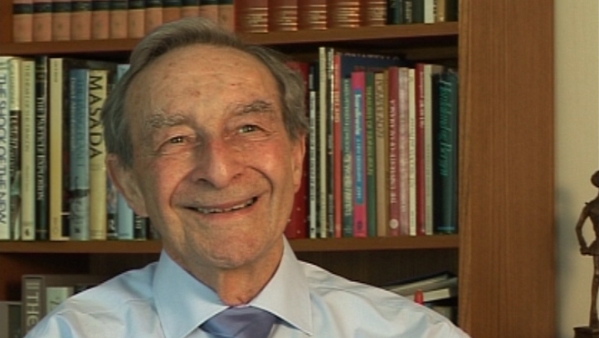NEXT STORY

Visiting the Buddhist temple in Kelaniya Vihara
RELATED STORIES

NEXT STORY

Visiting the Buddhist temple in Kelaniya Vihara
RELATED STORIES


|
Views | Duration | |
|---|---|---|---|
| 31. Hitchhiking: the beauty of Sydney | 52 | 02:13 | |
| 32. Lamington Park and the Antarctic forest | 53 | 02:31 | |
| 33. Taking the liner to England | 53 | 03:06 | |
| 34. Passing through the Suez Canal | 55 | 01:51 | |
| 35. Visiting the Buddhist temple in Kelaniya Vihara | 52 | 02:49 | |
| 36. Passing through Aden | 49 | 00:50 | |
| 37. Reaching England | 65 | 03:00 | |
| 38. Harry Emeléus | 69 | 01:06 | |
| 39. Arriving in Cambridge | 186 | 02:28 | |
| 40. Meeting my paternal relations | 70 | 02:20 |


So I came through the Suez Canal, but that was also, as it happens, an experience, because – and we give a couple of dates here – I came in August... beginning of August 1948, and in the beginning of May in 1948, the State of Israel was created and recognised, first by Britain and the United States, and then by other countries. But, as you know, when it was created it also created a state of war with the neighbouring Arab cases... Arab countries, so there was a state of war, and that had an impact on the Suez Canal because it was a military zone. It didn’t close the canal, but it meant that you had to stay onboard ship. But fortunately for us, we were – and this is three months afterwards – the traders in Port Said, which is the northern end of Suez Canal, revolted, went on strike, whatever word they use, and they said, ‘We have no livelihood, we live off these liners coming and spending a day, with the tourists coming onshore’, and so they threatened some action. As a result, it was agreed that we could spend the afternoon onshore, so I was actually on the first ship that was allowed to put down passengers after the war started in May of 1948. Then we went through the Mediterranean, we saw the Straits of Gibraltar, and all of these things for an Australian were a great experience.
Norman Greenwood (1925-2012) was born in Australia and graduated from Melbourne University before going to Cambridge. His wide-ranging research in inorganic and structural chemistry made major advances in the chemistry of boron hydrides and other main-group element compounds. He also pioneered the application of Mössbauer spectroscopy to problems in chemistry. He was a prolific writer and inspirational lecturer on chemical and educational themes, and held numerous visiting professorships throughout the world.
Title: Passing through the Suez Canal
Listeners: Brian Johnson
Professor Brian FG Johnson FRS, FRSE, FRS Chem, FAcad Eu, FAS. Professor of Inorganic Chemistry University of Edinburgh 1991-1995, Professor of Inorganic Chemistry University of Cambridge 1995-2005, Master Fitzwilliam College Cambridge 1999-2005. Research interests include studies of transition metal carbonyls, organometallic chemistry, nano- particles and homogeneous catalysis. Professor Johnson is the author of over 1000 research articles and papers.
Tags: Suez Canal, 1948, Israel, UK, USA: Port Said, Mediterranean Sea, Straits of Gibraltar
Duration: 1 minute, 51 seconds
Date story recorded: May 2011
Date story went live: 25 November 2011